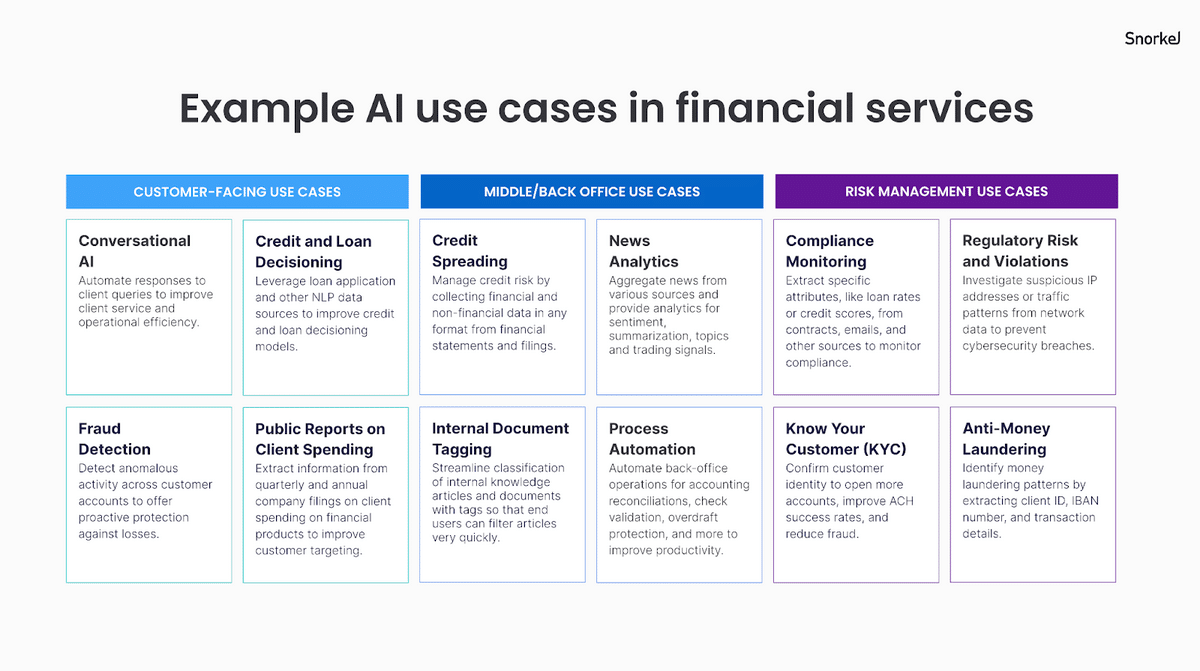New Snorkel benchmark leaderboards. See the results.
AI for banking in the era of ChatGPT
Why 5 of the Top 10 US banks choose Snorkel AI
The finance industry has long been regarded as an extremely complex space. Among many other challenges, it faces strict and frequently changing regulations, sophisticated and highly incentivized adversaries—all coupled with critical infrastructure demands.
It’s no surprise, then, that forward-looking companies in the finance sector, including banks, have looked to technology as one way to meet these challenges and are reaping the rewards of doing so.
Banks invest heavily in AI or risk being left behind
Accenture reports that banks can handle 2-5x as many interactions when they use AI-based solutions, and reaching those results doesn’t require any changes to headcount. In a related report, Reuters cited a BCG study that expects “grunt work” at banks to decrease by 2.4 hours per employee per day by 2027. All of this AI-enabled efficiency could yield an additional $1 trillion in value annually for the banking sector, according to a McKinsey estimate.
Eager to capitalize on these opportunities, banks are quickly working to better adopt AI. The same McKinsey report states that 60% of financial-sector survey respondents said their company had already launched at least one AI capability. According to another survey seen and reported on by Business Insider, 75% of respondents working at banks with more than $100 billion in assets were currently implementing AI strategies.
Where banks are focusing within AI
AI initiatives span every part of a banking business; these institutions hope to streamline their operations, automate routine tasks, improve the customer experience, and reduce costs. Back offices, for example, employ applications that extract information to guide loan underwriting and manage compliance. Middle offices use AI to process form information to help with Know-Your-Customer (KYC) efforts, surveillance, and risk management. But banks have made their largest investments in areas that benefit front offices—particularly in chatbots.

While banks have been investing in AI to detect fraud for years, Cornerstone Advisors’ “What’s Going on in Banking 2023” report says that banks are currently making big bets on conversational AI. Conversational AI and chatbots significantly improve the volume of interactions that banks can handle while also decreasing the resolution time—without changing the number of employees. Conversational AI can also help triage and track customer complaints and service requests, which leads to better customer experiences, significant cost savings, and more efficiency for employees.
Cornerstone Advisors even told Forbes that conversational AI stands as the #1 technology investment for banks this year, outranking commercial digital banking (#2), customer relations management tools (#3), and real-time payments (#4).
The challenges in leveraging ChatGPT
Given the wide range of applications covered by banks’ AI strategies and the immense impact of landing the strategies well, banks need a partner who can help them deliver valuable and reliable AI utilities quickly.
Even with the significant advances with ChatGPT, GPT-4, LLaMA, and others, foundation models or large language models (LLMs) require significant fine-tuning using task- and domain-specific training. This is especially true for complex, high-value use cases such as conversational AI, fraud detection, anti-money laundering, and more. There is a high accuracy bar and a need for transparency when putting these models in production as they are used for automation with little-to-none human involvement.
Foundation models/LLMs, and AI in general, needs to be adapted for your use case and constraints (infrastructure, latency, cost, transparency, etc) using your data and knowledge. But for most organizations, the path to customizing ML models and improving their accuracy is neither straightforward nor scalable.
Traditionally, data scientists have relied on iterating on model parameters or experimenting with different architectures with limited training data development. However, for models with billions of parameters, it is nearly impossible to tweak individual parameters. Instead, leading, AI-first organizations are adopting a data-centric approach to AI development. Data scientists iterate on developing high-quality, domain and task-specific training data to train high-quality models.
However, for most organizations training data development is a manual, slow, and expensive process whether carried out in-house or outsourced. In fact, outsourcing is not an option when data is private, fast-changing, or so highly specialized that it requires subject matter experts to label it.

Adopting data-centric AI with Snorkel Flow
Snorkel was developed at Stanford AI lab and is designed to help enterprise AI teams fine-tune foundation models/LLMs for their tasks using their data.
Snorkel uses a weak supervision approach to generate labels for training data. It involves creating labeling functions that can automatically label a dataset. These functions can be based on heuristics, patterns, or other domain knowledge. Then, Snorkel combines these noisy labels to generate a single, probabilistic label per data point. This resulting labeled dataset can be used to train machine learning models with better performance than using traditional hand-labeled data.
By automating the data labeling process, Snorkel AI helps reduce the time, cost, and effort required to create high-quality labeled data. Five of the top 10 US banks use Snorkel to accelerate AI development by 10-100x.
Here are a few reasons Snorkel delivers outsized impact for financial services:
- Highly adaptable: High-quality training data is crucial for AI initiatives, but frequent changes in regulations, document structures, and objectives require a flexible solution that allows for rapid iteration. Snorkel Flow (Snorkel AI’s flagship product) enables banks to rapidly adjust data labels by harnessing programmatic labeling.
- Easy collaboration: Many use cases within the banking industry rely on deep domain expertise, often held by less technical team members. Snorkel Flow supports collaboration between subject matter experts and data science teams end-to-end. This allows subject matter experts to efficiently provide their knowledge to data scientists, who can then quickly build useful models.
- Strong governance: Banks must be able to explain how a specific decision was made when regulators ask. Snorkel Flow reduces the cost of labeling data in-house, while also increasing the explainability of model predictions. The process of programmatic labeling provides a detailed audit trail of how data labels were generated and incorporated into the model, making it easier to explain how the model arrived at its predictions.
Banks accelerate AI development and unlock innovation with Snorkel AI
Banks using Snorkel Flow have realized value from AI faster, reduced costs, and unlocked new initiatives across the organization. Our banking customers have saved between 2,000 and 10,000 hours of subject matter expert time across multiple projects, freeing financial analysts and investment managers to focus on their core functions. One top US bank saw the time needed to extract information from documents from Know Your Customer (KYC) processing drop from 30-90 minutes per document to just 1-3 seconds—a mere 0.06% of the original time!
Models built on Snorkel Flow deliver high-quality results. One customer saw a 25+ point performance gain over a black box vendor solution, while also empowering their team to work at 45x the speed compared to hand-labeling. This increase in quality has important and meaningful results—better experiences for customers engaging with chatbots, more accurate lending decisions, and better, faster identification of fraudulent activity—with fewer false positives.
The flexibility to choose from multiple external language models, as well as the ability to efficiently fine-tune these models to your tasks, resolve bias and overfitting with real-time monitoring, and have a clear lineage for risk mitigation, will become increasingly vital capabilities for organizations looking to deploy machine learning at scale. That’s why many banks have partnered with Snorkel.
We’re excited to help our customers continue to drive meaningful results like these and to help our banking partners realize the immense opportunity that AI presents to the industry. If you want to learn more, you can check out our case studies such as the ones discussing a top US bank, a Fortune 50 bank, and a global custodian bank.
Learn More
Follow Snorkel AI on LinkedIn, Twitter, and YouTube to be the first to see new posts and videos!
Harshini Jayaram is the Director of Business Operations & Growth at Snorkel AI, a company that helps enterprises build cutting-edge, data-centric AI solutions. Prior to Snorkel, she worked at Microsoft and was most recently a part of Azure Identity, where she helped companies move from legacy solutions to modern, cloud-based offerings. Harshini’s experience also reaches into the public sector, including time as a Policy Fellow in the U.S. House of Representatives, work with the City of Boston on reducing the digital divide, and participating in the Technology and Public Purpose Project, led by former U.S. Secretary of Defense Ash Carter, to help build technology with the public good in mind. Harshini has a B.S. in computer science from MIT, as well as an MBA and an MPP from Harvard.
